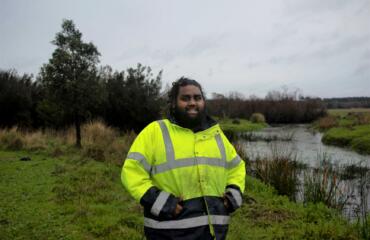Australians have a very special and unfortunate relationship with extinction. As a country we are responsible for 30 per cent of all mammal extinctions globally. Biodiversity loss continues, with 8 million hectares of threatened species habitat – an area larger than the size of Tasmania – lost since 2000.
Striving to communicate the scale of the emergency, conservation ecologist Professor Brendan Wintle put it this way: “On a scale of one to ten, we’re pretty damn close to ten.”
Wintle delivered his bleak assessment at an expert discussion hosted by the University of Melbourne on the biodiversity crisis earlier this week.
Life on Earth is undergoing the greatest spike in extinction rates since the vanishing of the dinosaurs, he said, with a 2019 UN report identifying more than a million species at risk globally. It’s a crisis driven by massive scale clearing and habitat loss, climate change and the introduction of invasive species.
To stave off disaster, nearly half of all land on the planet needs improved conservation, according to research just published in the journal Science, co-authored by 19 scientists including Wintle.
Wintle said official reviews and senate inquiries had repeatedly found Australia was failing to properly resource biodiversity conservation. An estimated $1.5 to 2 billion was needed annually “in order to hang on to that list of 1,800 species that are at high risk of extinction.
“So that sounds like a fair bit of money, right? … But it is worth reflecting that last year as a nation we spent $30.7 billion just on caring for our cats and our dog pets… even if we just use the GST from our cat and dog care we could actually provide $3 billion a year to conserve our natural heritage.”
Zoos Victoria chief executive, Dr Jenny Gray said Victorians could “move the dial” on half of its list of threatened species.
“Surely we can save them.”
There were interventions that could move a species one step further away from extinction, she said.
Gray described the successful joint effort to bring the Eastern Barred Bandicoot back from the brink in Victoria.

Eastern Barred Bandicoot. Photo by Zoos Victoria
Thirty-five years ago the species was listed as extinct in the wild in Victoria, although it still survived in Tasmania. A group of government bodies, donors, academics and little children worked together over decades towards a goal of three freestanding populations of 1500 bandicoots in the wild.
Last year, the animal had its conservation status changed from extinct to endangered.
Victorians should be proud, she said. “We brought a species back from extinct in the wild, to a point where they’re now living in really strong numbers.”
Gray called on each of the 2000 people attending the event in person and online to visit Victoria’s Flora and Fauna Guarantee Act listing “find a species, learn some more, and take some action”. Her own selection was a plant called the Snottygobble. “I’ve got that one, you can look for something else”.

Sea otters rafting. Photo by
USFWS Pacific Southwest Region licensed under CC BY 2.0.
Working together, enlisting a lesson from nature which she called “rafting”, was critical.
“Otters do that”, she said. “If you are on your own on the ocean as a sea otter, that’s a bit scary. If you just hold the one next to you, and they hold the next one, before you know it you’ve got a carpet of otters.”
Dr Jack Pascoe, conservation and research manager at the Conservation Ecology Centre, said the root of many problems stemmed from a culture that had separated itself from biodiversity and Country.
“Bunjil’s first law is to look after Country like it’s your mother … biodiversity is something we’re related to and a part of,” he said.
“Once you start to take that perspective on life … you can’t help but respect and look after Country.”
He said great strides can be made by combining Indigenous knowledge with the best science to address the really big challenges of land management across Victoria.
Pascoe described his own work focussed on restoring Cape Otway’s wilderness. He said 10 to 15 years ago the forest had collapsed, the trees were gone and the understory had taken over.
“Over the course of a decade, we planted trees, re-established a fire regime, we tried to encourage biodiversity to come back … it took us a while to get it right.
“And I think we’re slowly getting there. As I said, it’s sand country so the trees grow insanely slow. But they’re now bigger than I am,” he said.
“ And I think probably before I die someone will bring me out there and it’ll be forest.”



